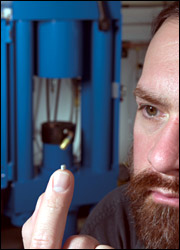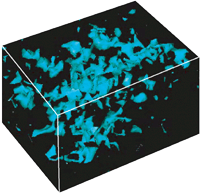
|
 |
Research > Science
Highlights > From Tiny Grains, a Larger Understanding
of Earth
From Tiny Grains, a Larger Understanding of Earth
 |
 |
Scientists
can’t observe magma moving beneath the seafloor, so Glenn
Gaetani makes his own sample of the molten rock by subjecting
a tiny capsule of powder that simulates rock in the upper
mantle to crushing pressure and intense heat in his laboratory.
(Photo by Tom Kleindinst)
|
 |
| A 3-D microtomography
image of the sample (above) shows the internal structure
of the mineral grains, revealing to researchers how the
melting magma (blue) has started to pool and flow along
the edges and corners of the dark grains. The work is
part of a larger effort at WHOI to understand Earth processes,
including how magma forms and rises through seafloor cracks
to carpet the ocean bottom with new crust. (Photo by Tom
Kleindinst) |
Fifty miles below the ocean bottom, where extreme pressure meets
temperatures exceeding 2,000 degrees Fahrenheit, rock is squeezed
and cooked until it begins to flow like hot syrup. This is the
birthplace of magma, the molten rock that rises to erupt from
undersea volcanoes or oozes from deep fissures, cooling and
solidifying as it hits cold seawater to carpet the seafloor
with new crust.
The process has continually paved and repaved two-thirds of Earth’s surface, yet it remains a fundamental
mystery. For more than 40 years, scientists have been working to learn why magma forms, how it moves through the mantle, and what makes it erupt from the seafloor. Knowing this will help scientists understand the very processes that formed the Earth, and will help them learn about—and perhaps better predict—earthquakes and volcanic eruptions.
The key to understanding this world-shaping dynamic,
however, may lie in the interstices between the microscopic mineral grains that make up mantle rock, where all the melting and moving begins.
“People are used to seeing pictures of magma boiling out of volcanoes or the seafloor, but I wonder
if they think about it all starting on grains smaller than sand,” said Glenn Gaetani, a petrologist
and geochemist in the Geology and Geophysics Department.
A new imaging technique called microtomography is giving scientists the previously impossible ability to clearly see the individual mineral grains composing mantle rock. Shaped like circles, squares, and hexagons,
the grains resemble a jumble of toy blocks. For Wenlu Zhu, a geophysicist at WHOI, these outwardly
simple shapes provide some answers to complex questions about magma.
At the microscopic scale, individual grains of olivine,
pyroxene, and other minerals that are the precursors
to magma begin to melt along grain surfaces. Small drops of magma form larger puddles along the curved and straight edges between grains. The puddles then channel together into larger pools, gaining momentum
and mass as they collect. The pools become rivers of magma that, driven by buoyancy and gas pressure, eventually ascend all the way to the seafloor.
Zhu can’t collect magma at its source in the mantle, so in August she began working with Gaetani to make her own magma and simulate conditions 50 miles down. After mixing a chemical recipe, Gaetani squeezes
the sample in a hydraulic press and bakes it, creating
a substance with the same chemical and physical makeup as the molten magma found in Earth’s mantle.
Zhu then examines the samples using microtomography,
which takes X-ray images at many angles around the object and reveals the internal structure of the grains that make up mantle rock. More powerful
than a computerized axial tomography (CAT) scan, microtomography can capture 3-D images of grains with viewing detail as small as two thousandths of a millimeter, or about twenty times smaller than a strand of human hair.
Zhu’s work is part of a larger effort at WHOI to understand Earth processes. Several scientists have overlapping research interests: Greg Hirth, a geophysicist,
studies processes that govern the strength of faults and the depth of earthquakes at Earth’s plate boundaries; John Collins, a geophysicist, studies the structure of ocean crust and the upper mantle by analyzing
seismic waves traveling through Earth; and Stan Hart, a geochemist, focuses on the evolution of hot spots and the formation of Earth’s mantle.
“For all of us, it’s a chance to learn about how the seafloor is created, and how some of the land we stand on is formed,” said Zhu.
—Amy E. Nevala (anevala@whoi.edu)
|
|
